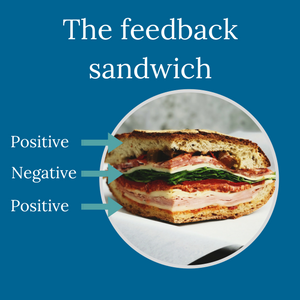 When you need to speak to an employee to give negative feedback do you try to soften it by surrounding it with positive feedback too? Put a slice of praise on the top and bottom and then stick the meat of your criticism in between these two slices. The feedback sandwich is a technique that many people use, but is it really the optimum way to deliver feedback? Ask yourself are you using this method for the good of the receiver of the feedback, or is it to make yourself feel better when delivering it?
When you need to speak to an employee to give negative feedback do you try to soften it by surrounding it with positive feedback too? Put a slice of praise on the top and bottom and then stick the meat of your criticism in between these two slices. The feedback sandwich is a technique that many people use, but is it really the optimum way to deliver feedback? Ask yourself are you using this method for the good of the receiver of the feedback, or is it to make yourself feel better when delivering it?
Why do people use this approach?
They make think it is easier for people to hear something negative when it also comes with something positive, making it more balanced. They may also be hoping to reduce people’s anxiety and discomfort with hearing negative feedback by easing them in to it and ending on a positive so that they don’t feel too deflated.
The problems
When you need to address an issue with an employee start by thinking how you would want to receive the feedback. If you use this method of the sandwich feedback, you run the risk of the following:
- The positive feedback isn’t actually heard and comes across as being insincere. They are waiting for the criticism which can actually build on their anxiety, exactly the opposite of what you were attempting to do.
- Or by giving the positive feedback you actually drown out the message of the negative feedback, which in fact was the main purpose of the conversation. People will often remember what happens first and last in a conversation and may well gloss over the middle, so your feedback runs the risk of being forgotten or discounted.
What should you do?
If you want to be an effective leader then you need to be transparent and clear, and not controlling and manipulative when you are giving feedback.
Research shows that whatever type of feedback you are giving (positive or negative) it is best shared as soon as possible, in a timely manner. People respect honest and accurate feedback about their work and they want to learn how to improve.
You should prepare for any meeting in which you will be providing constructive feedback. As a leader, you play a powerful and influential role in all of your employees’ lives at work. Therefore, it is essential that you prepare your approach and what you are going to say, using good examples to deliver feedback.
Make sure you describe the context of the situation and list your observations, express your views and explain their values whilst offering suggestions. It is worth asking your employee if they would like to have some feedback and perhaps give them the opportunity to give their own feedback. Have a mutual learning approach and make it a conversation rather than a monologue. It’s important when you are delivering feedback that you don’t do it in a superior way, but rather that you are offering your opinions and perspective.
Don’t bombard someone with too much feedback. Instead concentrate on one major aspect at a time and make an action plan with them.
The feedback sandwich is an outdated and not particularly effective approach to giving feedback. By giving negative feedback in a transparent way it will feel more genuine to your employees when they receive it, whether it is negative or positive, and this will lower their discomfort and anxiety in the process.